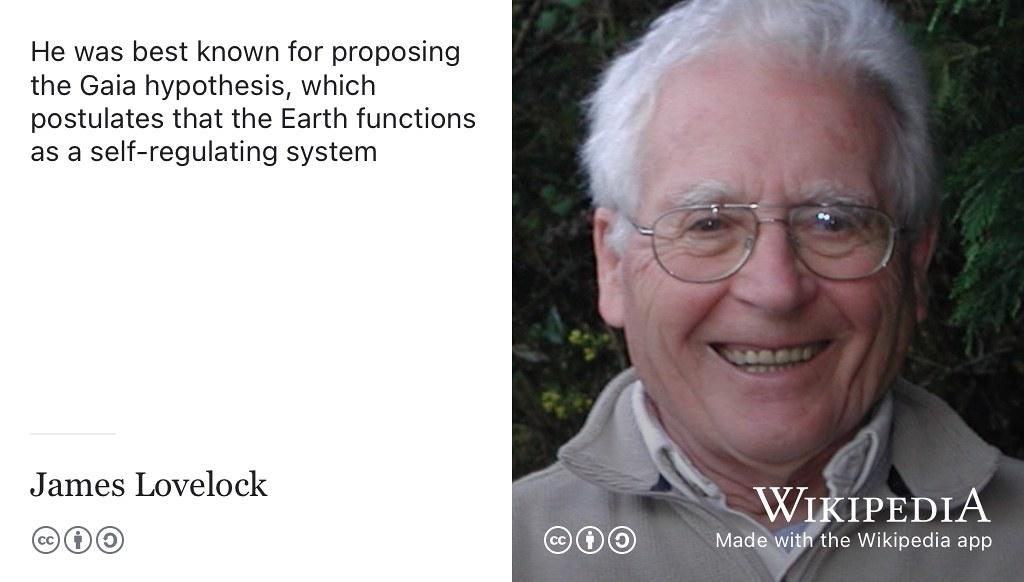In a world where the delicate balance between nature and humanity is more crucial than ever, the concept of Gaia theory introduced by James Lovelock emerges as a reminder of our interconnectedness with the planet. As we delve into the depths of Lovelock’s profound insights, we unravel a tapestry of symbiosis between Earth and all its inhabitants. Join us on a journey to explore the profound wisdom of James Lovelock and discover how we truly belong to Gaia.
Table of Contents
- Exploring James Lovelock’s Gaia Theory
- Unveiling the Concept of Being Part of Gaia
- Implications of James Lovelock’s Theory on Environmental Awareness
- Embracing Gaia as a Framework for Sustainable Living
- Q&A
- Future Outlook

Exploring James Lovelock’s Gaia Theory
James Lovelock’s Gaia Theory proposes a groundbreaking perspective on the interconnectedness of life on Earth. According to this theory, the planet functions as a single, self-regulating organism where all living and non-living components interact to maintain a complex system in balance. The concept challenges traditional views of the Earth as merely a collection of separate entities, emphasizing the holistic nature of our planet.
Through Gaia Theory, Lovelock suggests that humans are not separate from nature but an integral part of it, highlighting our responsibility to nurture and protect our environment. By recognizing our connection to Gaia, we can cultivate a deeper appreciation for the delicate harmony that sustains life on Earth and strive towards a more sustainable future for generations to come.
Unveiling the Concept of Being Part of Gaia
Connecting with Gaia is a profound journey that transcends individual existence and embraces the interconnectedness of all living beings. The essence of being part of Gaia lies in recognizing the harmonious balance between humanity and the natural world. By acknowledging our interdependence with the Earth, we awaken to a deeper understanding of our role as stewards of this planet.
Embracing the concept of Gaia invites us to reflect on our impact on the environment and cultivate a sense of responsibility towards preserving the delicate ecosystems that sustain life. Through mindful actions and sustainable practices, we can nourish the bond between humanity and Gaia, fostering a future where unity and respect for nature flourish. Let us unite in reverence for Gaia’s beauty and wisdom, honoring the interconnected web of life that sustains us all.

Implications of James Lovelock’s Theory on Environmental Awareness
James Lovelock’s Gaia hypothesis proposes a unique perspective on our relationship with the Earth. By likening the planet to a self-regulating organism, he challenges us to reconsider how we interact with our environment. This paradigm shift prompts us to view the Earth not just as a place we inhabit but as a living entity we are intrinsically connected to.
- This perspective fosters a sense of responsibility towards environmental conservation and sustainability.
- It highlights the interdependence of all living beings and ecosystems.
- The Gaia theory emphasizes the need for global cooperation to address environmental challenges.
Embracing Lovelock’s concept encourages us to reevaluate our role as stewards of the planet. By recognizing our interconnectedness with Gaia, we are inspired to make conscious choices that preserve and protect the delicate balance of our shared home.

Embracing Gaia as a Framework for Sustainable Living
involves recognizing the interconnectedness of all living beings on this planet. By understanding that we are part of a larger system, we can make decisions that nurture the Earth and promote harmony among its inhabitants. This shift in perspective encourages us to live in balance with nature, honoring its rhythms and fostering a sense of respect for the environment.
When we acknowledge our connection to Gaia, we become stewards of the Earth, responsible for protecting its delicate ecosystems and preserving its beauty for future generations. By embracing sustainable practices such as organic farming, renewable energy sources, and conservation efforts, we can contribute to the well-being of the planet and ensure a more harmonious coexistence with nature.
Q&A
**Q&A: Exploring James Lovelock’s Concept of Gaia**
Q: Who is James Lovelock and what is his concept of Gaia?
A: James Lovelock is a prominent British scientist known for proposing the Gaia hypothesis, which suggests that the Earth functions as a self-regulating system, like a living organism. According to Lovelock, Earth’s biosphere and physical components interact to maintain conditions suitable for life.
Q: How does Lovelock’s concept of Gaia differ from traditional views of the Earth?
A: Unlike traditional views that consider Earth as a passive environment, Lovelock’s Gaia theory portrays Earth as a complex, interconnected system where living organisms and their environment are intricately linked in a way that regulates the planet’s conditions.
Q: What evidence supports the Gaia hypothesis?
A: Lovelock points to various biological, chemical, and geological processes that contribute to the stability of Earth’s environment, such as the regulation of temperature, atmospheric composition, and ocean salinity, indicating a dynamic interaction between living organisms and Earth’s conditions.
Q: How has Lovelock’s Gaia theory influenced environmental science and sustainability efforts?
A: Lovelock’s Gaia hypothesis has sparked discussions about the interconnectedness of nature and the importance of preserving Earth’s delicate balance. It has inspired ecological thinking and efforts to promote sustainability by emphasizing the need to respect and protect the planet’s capacity to support life.
Q: What are some criticisms of the Gaia hypothesis?
A: Critics argue that the Gaia hypothesis presents Earth as too purposeful or anthropomorphic, attributing intentionality to processes that are purely natural. Some also question the practicality of applying the Gaia concept to environmental management strategies.
Q: How can individuals apply the principles of Gaia in their daily lives?
A: By understanding the interconnectedness of all life forms and ecosystems, individuals can make more mindful choices that promote environmental well-being, such as reducing waste, conserving resources, supporting biodiversity, and advocating for sustainable practices in their communities.
Future Outlook
In conclusion, exploring James Lovelock’s concept of Gaia reminds us of our interconnectedness with the planet we call home. Embracing the notion that we are not just inhabitants of Earth but integral parts of a living, self-regulating system can inspire a profound shift in how we view and interact with our environment. By recognizing our interconnectedness with Gaia, we may find a path towards sustainable coexistence and a renewed sense of responsibility towards the preservation of our planet. Let us continue to nurture this connection and work towards a harmonious relationship with Gaia for the benefit of present and future generations.



0 Comments